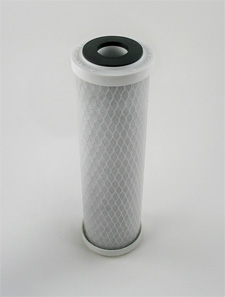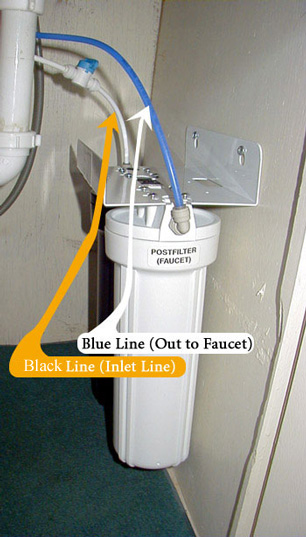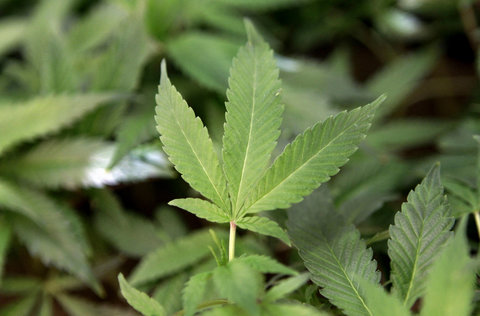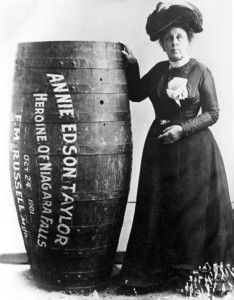Undersink Drinking Water Filters: Dollar for dollar, the best value in drinking water treatment products.
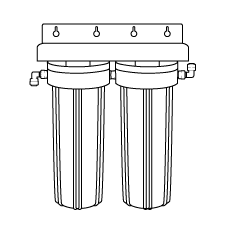
Double undersink filter with standard housings.
The double filter shown above comes with its own ledge faucet and inlet adapter. Just push in the faucet and inlet tubes and it’s ready to go.
Multi-cartridge drinking water filters are much under-rated. A good undersink double or triple filter can produce very high quality drinking water for many years with maximum efficiency, minimum maintenance, and at a cost that is only a fraction of that of bottled water. Undersink filters do not consume water (like reverse osmosis) or electricity (like a distiller). They are economical performers with a basic simplicity that makes them almost maintenance-free.
Undersink water filters come in several formats. For the two most basic styles we have technical terms. We call them the standard and the simple.
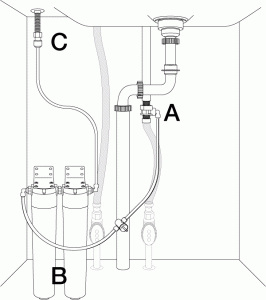
Pictured above is a standard undersink filter. It gets its water from the undersink cold water pipe at point A, then sends it via a flexible plastic tube to the water filter (B). It leaves the water filter through a flexible plastic tube (C) and is delivered to the user through the filter’s own special faucet, mounted on top of the sink.
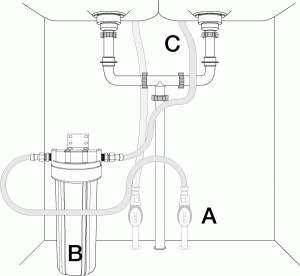
The simple filter style shown above uses the cold water side of the regular sink faucet to dispense water. All of the cold water that goes to the sink is diverted through the filter and comes out as treated water. No separate faucet is needed. The hot water is not filtered.
The simple version without a separate ledge faucet is becoming more popular and more practical with the advent of flexible rather than hard copper undersink piping and harder to drill granite countertops. Flexible delivery pipes make installation of simple undersink units very easy and inexpensive. Nevertheless, the standard dedicated-faucet style remains the most popular.
The chart below shows the pros and cons of the two models.
Conventional vs. Simple Undersink Filters
|
Conventional
|
Simple
|
| More expensive. Needs its own faucet. |
Less expensive. No additional faucet needed. |
| Hole needed in sink for faucet installation. |
No hole needed for additional faucet. |
| Filter cartridges last longer because only drinking and cooking water is filtered. |
More frequent cartridge replacement since all cold water is filtered. |
| Higher quality water can be produced due to reduced flow rate. |
Higher flow rate makes some filtration tasks less practical. (Fluoride or bacteria reduction, for example.) |
| Installs easily on either all-copper or flexible piping. |
Can be installed on any undersink piping, but it’s much easier where flexible connectors are used. |
| Greater model choice available because of reduced flow rate. |
Only full-sized filters with 3/8″ or larger ports should be used. |
Our Black and White Series of Standard Undersink Filters
Pure Water Products’ basic Black and White undersink series includes single, double, triple, and even quadruple undersink filters. All use top quality, heavy-duty parts. All are standard sized to make parts easy to find, and they are so tough that you normally never need parts except filter cartridge replacements. Filter cartridges are the most common size made, the basic “10-inch filter” (9.75″ X 2.5″) sold everywhere.
The basic Black and White undersink units include a choice of our basic Tomlinson Pro-Flo faucet (top picture) or the Tomlinson
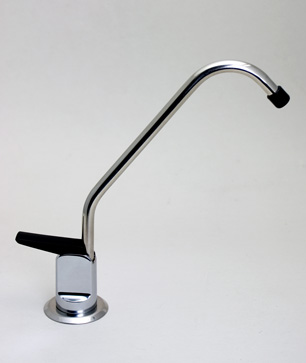
“Contemporary Value” faucet (bottom picture). Other styles and finishes are available on our faucet page. Black and White undersink units also come with an inlet valve appropriate for your situation. Fittings are all John Guest or Mur-lok quick connect. Push the tubing into the fitting and forget it. Everything is designed for easy installation and upkeep and long, dependable service. Installation is simply installing the faucet and the inlet valve, then pushing tubes into two quick-connect fittings. Full instructions are included.
All our Black & White single, double, triple and quadruple filters are mounted on brackets and can be either hung on the wall or stood in a secure undersink location.
Filter Cartridges
The great thing about a multi-cartridge filter is that you can get multiple stages of carbon, the essential ingredient in most water treatment strategies, plus the ability to add specialty media to deal with targeted problems. Multi-cartridge design allows the user to customize the treatment unit to suit his water. Thus, a well planned undersink filter can address chemicals of all types–from disinfectants added by municipal water suppliers, the by-products of these disinfectants, and extraneous chemicals that accidentally enter the water supply. With the right cartridges they can also deal with lead and heavy metals, fluoride, cysts, bacteria, and aesthetic issues like taste and odor and low pH.
The main cartridge ingredient of most undersink filters is activated carbon. Carbon is the preferred treatment, and sometimes the only treatment for most chemical contaminants, and it is unequaled at taste/odor improvement. In cartridges carbon can be in granular form or it can be made into high performance carbon blocks. Carbon filter technology is rapidly improving. Some of the high performance carbon units available today were not possible just a few years ago. We have carbon filters made with standard bituminous carbon, coconut shell carbon, and specially enhanced “catalytic” carbon as well as carbon mixed with KDF redox medium for chlorine and heavy metals reduction and with calcite for pH increase.
We also supply a good number of specialty cartridges, top quality “media” filters to reduce specific problem contaminants like nitrates, arsenic, and fluoride. (I would stress, however, that the best way to deal with arsenic, nitrates, and fluoride is with an undersink reverse osmosis unit. Reverse osmosis handles these contaminants by its nature and does not need special cartridges.)
Black and White undersinks give customers the opportunity to design their own filtration unit. By choosing a single filter cartridge or combining two, three or four cartridges from the many we offer, a unique treatment system can be created. Here are some of the more popular cartridges. All cartridges are in the standard 9.75″ X 2.5″ size.
I’m listing only ten of the fifty plus cartridges we stock in the size of our Black and White undersink units. Most of the rest are in our “Cartridge Menu.”
When you buy a Black and White undersink unit, you can select from among all the cartridges in the Cartridge Menu. The price of the unit stays the same regardless of the cartridges you choose. Prices vary, of course, when cartridges are replaced.
Start
|
Part Number and Name
|
Filter Style
|
More Details
|
| FC001 MatriKX “CTO Plus” (formerly call KX-1), |
0.6 Micron Carbon Block, Bituminous Carbon |
High Chemical Capacity. Great Chlorine and Chloramine reduction. Our favorite carbon block and standard cartridge for single filters and double filters. Incredible 20,000 gallon chlorine reduction capacity. |
| FC002. MatriKX “VOC” (formerly called KX-5). |
0.6 Micron Carbon, Block, coconut shell carbon. |
High Chemical Capacity. Great Chlorine and Chloramine reduction. Especially good at VOC reduction. A popular cartridge that makes great tasting water. |
| FC004. MatriKX PB-1. |
0.5 Micron Carbon Block with Heavy Metals Resin added. |
High Capacity Chemical Cartridge, also removes lead and heavy metals plus cysts (giardia and cryptosporidium). A long-time favorite for single and double filters. |
| FC027. Pentek Chlor-Plus 10. |
1 Micron Carbon Block. |
Pentek Chlor-Plus 10 one-micron Carbon Block, designed especially for Chloramine Removal. 2,500 gallons of chloramine reduction at 0.5 gpm–1,000 gallons at 1.0 gpm. |
| FC008. PWP KDF1.5 GAC |
Granular Coconut Shell Carbon with 1.5 lbs. of KDF 55. |
Our own KDF drinking water cartridge. Long-term dechlorination, lead reduction, and excellent taste/odor improvement. |
| FC011. PWP Fluoride Reduction Cartridge. |
Granular Activated Alumina Cartridge, made with Resin-Tech’s SIR-900 Fluoride Resin. |
Our high quality fluoride cartridge made with the purest activated alumina. Also removes arsenic and lead. |
| FC026. Pentek CGAC-10 |
Granular Carbon in Pentek’s unique radial flow design. |
Granular Carbon Chloramine Reduction Cartridge. 3,500 gallons of chloramine reduction at 0.5 gpm–1,750 gallons at 1.0 gpm. Also excellent for chlorine and chemicals in general. |
| FC708. Doulton Imperial Super Sterasyl |
Free-Flowing Ceramic Cartridge with granular carbon core. |
Doulton Imperial Super Sterasyl open end cartridge. Large diameter Super Sterasyl—ceramic/silver outer shell with granular carbon core for chemical reduction and taste/odor improvement. Removes bacteria, cysts, chemicals. |
| FC020. PWP Centaur/KDF 85. |
Super Problem Well Water Cartridge. |
Our own granular cartridge designed for well water with sulfide and/or iron. Contains 1.5 pounds of KDF 85 (special iron/sulfide grade) with Centaur catalytic carbon, a specially designed carbon for sulfide/iron. |
| FC005. Flowmatic Arsenic Cartridge. |
Granular Iron Oxide. |
Flowmatic Iron Oxide Arsenic Removal Cartridge. Uses the safe and effective granular ferric oxide technology which is effective against both types of arsenic (Arsenic V and Arsenic III). The cartridge is rated for 1000 gallons of arsenic reduction at 0.75 gallons per minute. |
|
|
| Above, a Black & White double undersink filter, installed. Undersink filters are simple , effective, and economical.The standard unit shown above comes standard with two MatriKX carbon block filters, other cartridges may be substituted. |





![arundhatiroy[1]](http://www.purewatergazette.net/blog/wp-content/uploads/2012/04/arundhatiroy1.jpg)






